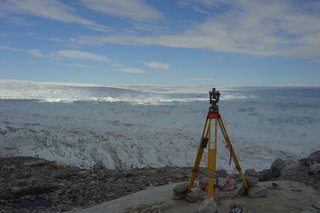
At first glance the site looked like a completely desolate place – just rock and ice – but summer had not yet arrived. Soon the remaining snow patches melted, the ponds dried up, and the flowers started to bloom in succession. I wish I knew the names: first purple flowers, then white, then yellow. Birds began passing through with increasing numbers: ravens, geese, ptarmigan, buntings, and an owl. We didn’t see any signs of larger life, but that’s fine by me – no polar bears came crashing through our campsite. Actually we had been told beforehand that bears don’t come through this area, but you never know…

The glacier was overwhelming at times. The ice flux through the terminus is about 50 km3 of ice per year – I think that’s something like 50 times the amount of water that Los Angeles uses in a year. The sounds of crevasses opening and closing, ice calving off the terminus, and icebergs grinding against each other reminded me of thunder (and growling bears). On a couple of occasions we documented enormous calving events with time-lapse photography. I hope to post a video of those events in the future. The terminal cliff may be the largest ice cliff in the world – it rises over 100 m above the water surface.
No comments:
Post a Comment